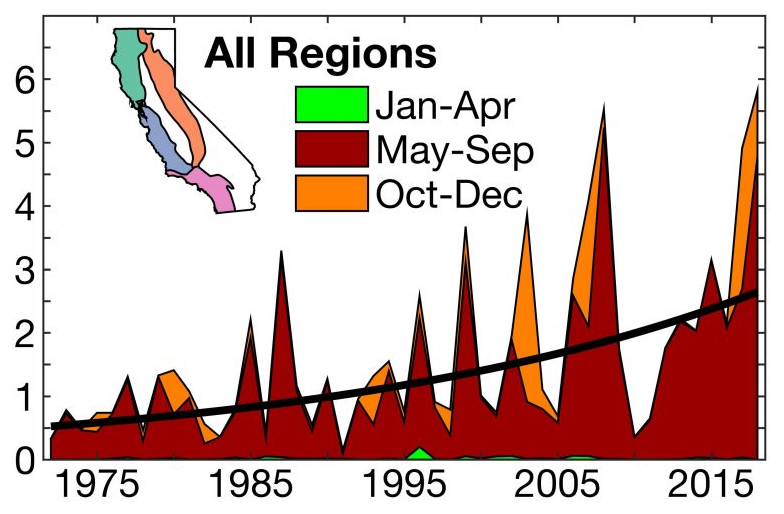Welcome to DU!
The truly grassroots left-of-center political community where regular people, not algorithms, drive the discussions and set the standards.
Join the community:
Create a free account
Support DU (and get rid of ads!):
Become a Star Member
Latest Breaking News
General Discussion
The DU Lounge
All Forums
Issue Forums
Culture Forums
Alliance Forums
Region Forums
Support Forums
Help & Search
Environment & Energy
Related: About this forumArea Of CA Forest Fires Up 5X; "Ability Of Dry Fuels To Promote Large Fires Is Non-Linear"

(Columbia University) – Against a backdrop of long-term rises in temperature in recent decades, California has seen ever higher spikes in seasonal wildfires, and, in the last two years, a string of disastrous, record-setting blazes. This has led scientists, politicians and media to ponder: what role might warming climate be playing here? A new study combs through the many factors that can promote wildfire, and concludes that in many, though not all, cases, warming climate is the decisive driver. The study finds in particular that the huge summer forest fires that have raked the North Coast and Sierra Nevada regions recently have a strong connection to arid ground conditions brought on by increasing heat. It suggests that wildfires could grow exponentially in the next 40 years, as temperatures continue to rise.
The study notes that average summer temperatures in the state have risen 3.25 degrees Fahrenheit since 1896, with three-quarters of that increase occurring since the early 1970s. From 1972 to 2018, the area burned annually has shot up fivefold, fueled mainly by a more than eightfold spike in summer forest fires. The researchers say the summer forest-fire increases are driven by a simple mechanism: when air heats up even modestly, it causes more moisture to evaporate from soils and vegetation. The result: fires start more easily, and can spread faster and farther. During the fall, and in non-forested areas, different dynamics may be at work and the results are less clear; but the researchers project that climate-driven aridity is likely to play a growing role there as well.
“It’s not a surprise to see that climate has this effect in forests, but California is so big and so variable, there is no one-size-fits-all explanation for how climate might affect wildfires across the board,” said the study’s lead author, Park Williams, a bioclimatologist at Columbia University’s Lamont-Doherty Earth Observatory. “We have tried to provide one-stop shopping to show people how climate has or, in some cases, hasn’t affected fire activity.” Williams and his colleagues have already shown in a 2016 study that heightened temperatures and resulting aridity on the ground has doubled the area burned in forest fires over wider areas of the U.S. West in past decades. The new study appears in the journal Earth’s Future.
The premise that warmer air draws moisture from the ground level — a phenomenon known as vapor pressure deficit — is already well established. However, many confounding factors can shift fire risk up or down, and so it is not always possible to measure the effects of vapor pressure deficit. In California, human infrastructure is sprawling into forests, introducing more chances for people to both cause fires and suffer from them. And a century of efforts to suppress virtually all fires has led to a buildup of flammable materials in many forests. On the other hand, fragmentation of forest landscapes by human intrusion may in some cases limit the spread of fires. Rainfall and snow can vary year to year, sometimes adding to fire risk, sometimes subtracting. And areas dominated by shrubs or grasses instead of trees may not react the same way.
EDIT

EDIT
https://desdemonadespair.net/2019/07/global-warming-drives-8x-increase-in-california-summer-wildfires-and-5x-increase-in-area-burned-the-ability-of-dry-fuels-to-promote-large-fires-is-non-linear.html
InfoView thread info, including edit history
TrashPut this thread in your Trash Can (My DU » Trash Can)
BookmarkAdd this thread to your Bookmarks (My DU » Bookmarks)
0 replies, 472 views
ShareGet links to this post and/or share on social media
AlertAlert this post for a rule violation
PowersThere are no powers you can use on this post
EditCannot edit other people's posts
ReplyReply to this post
EditCannot edit other people's posts
Rec (3)
ReplyReply to this post